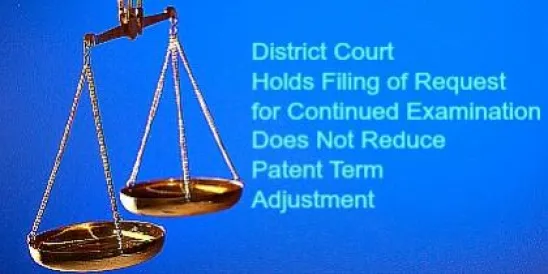On November 1, 2012, the District Court for the Eastern District of Virginia issued a decision in Exelixis v. Kappos (Case No. 1:12cv96), rejecting the U.S. Patent and Trademark Office’s (USPTO’s) interpretation of the statute which provides patentees with additional patent term to compensate for delays in prosecution caused by the USPTO. If upheld, this decision could result in extensions of patent term for many patentees where a request for continued examination was filed during prosecution and the USPTO has taken more than three years to issue a patent.
Patent Term Adjustment
35 U.S.C. § 154 specifies certain patent term guarantees which, if not met, can serve as bases for a patent term adjustment (PTA). In particular, 35 U.S.C. § 154(b)(1)(B) provides an applicant with one day of PTA for every day an application is pending for more than three years (also known as “B delay”). The statute specifies that certain events are not included in this three year guarantee, including “any time consumed by continued examination of the application requested by the applicant.” 35 U.S.C. § 154(b)(1)(B)(i). The question at issue in Exelixis was whether § 154(b)(1)(B) requires that PTA be reduced for time due to the filing of a Request for Continued Examination (RCE) where the RCE is filed after the end of the three year guarantee period. The USPTO has interpreted the statute to mean that time due to the filing of an RCE is always excluded from the calculation of B delay, regardless of when the RCE is filed.
The District Court’s Decision
In Exelixis, the District Court rejected the USPTO’s interpretation and granted summary judgment to Exelixis. The District Court found that § 154(b)(1)(B) describes two calculations: the calculation of the three year guarantee period and the calculation of the day for day addition to the PTA for every day beyond the end of the three year period until the patent issues. According to the District Court, the plain language of the statute clearly and unambiguously indicates that the exclusion of time attributable to the filing of an RCE applies only to the measurement of the three year period, and not to the PTA calculation. The Court noted that because § 154(b)(1)(B) does not address the filing of an RCE after the end of the three year period, it is clear that PTA is awarded by the statute on a day for day basis once the three year period has ended, regardless of subsequent events. Additionally, because the purpose of the statute is to provide an applicant with PTA to remedy delays attributable to the USPTO and to reduce PTA for delays attributable to the applicant, the Court found its interpretation was consistent with the statute’s purpose because the statute does not identify an RCE as an applicant delay.
Exelixis is the first decision in a series of cases pending at the District Court raising similar challenges of the USPTO’s interpretation of § 154(b)(1)(B). If upheld, patentees may be entitled to PTA or to a longer PTA where an RCE was filed, particularly in technology areas where applications
are typically pending for more than three years. Furthermore, the Exelixis decision may support an adjustment of PTA for other actions under § 154(b)(1)(B)(ii) and (iii) that the USPTO has also excluded from B delay, such as time consumed by appellate review. It is therefore advisable to determine whether patents and applications might benefit under the Exelixis decision and, where applicable, file a request to reconsider the PTA at the USPTO or file suit at the District Court.





 />i
/>i
